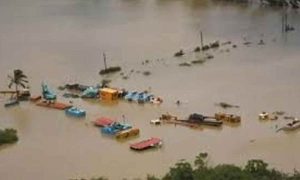Third Consecutive La Nina Event:

Australia’s Bureau of Meteorology (BOM) predicted, that a third consecutive event of La Nina could be underway which could lead to unusual weather effects in various countries.
- There is an extended period of La Nina in 2022.
- It is the first time that this has happened since the 1950s when the event started to be recorded. The years 1973-76 and 1998-2001 were consecutive La Nina years.
La Nina and El Nino:
- In the neutral state (neither El Niño nor La Niña) trade winds blow east to west across the surface of the tropical Pacific Ocean, bringing warm moist air and warmer surface waters towards the western Pacific and keeping the central Pacific Ocean relatively cool.
- Warm sea surface temperatures in the western Pacific pump heat and moisture into the atmosphere above.
- In a process known as atmospheric convection, this warm air rises high into the atmosphere and, if the air is moist enough, causes towering cumulonimbus clouds and rain.
- The pattern of air rising in the west and falling in the east with westward moving air at the surface is referred to as the Walker Circulation.
La Nina:
- La Nina means the Little Girl in Spanish. It is also sometimes called El Viejo, anti-El Nino, or simply “a cold event.”
- La Nina events represent periods of below-average sea surface temperatures across the east-central Equatorial Pacific.
- It is indicated by sea-surface temperature decreased by more than 0.9℉ for at least five successive three-month seasons.
- La Nina event is observed when the water temperature in the Eastern Pacific gets comparatively colder than normal, as a consequence of which, there is a strong high pressure over the eastern equatorial Pacific.
- There are increased temperatures in Western Pacific, Indian Ocean and off the Somalian coast.
EL Nino:
- El Nino is a climate pattern that describes the unusual warming of surface waters in the eastern tropical Pacific Ocean.
- It is the “warm phase” of a larger phenomenon called the El Nino-Southern Oscillation (ENSO).
- It occurs more frequently than La Nina.




